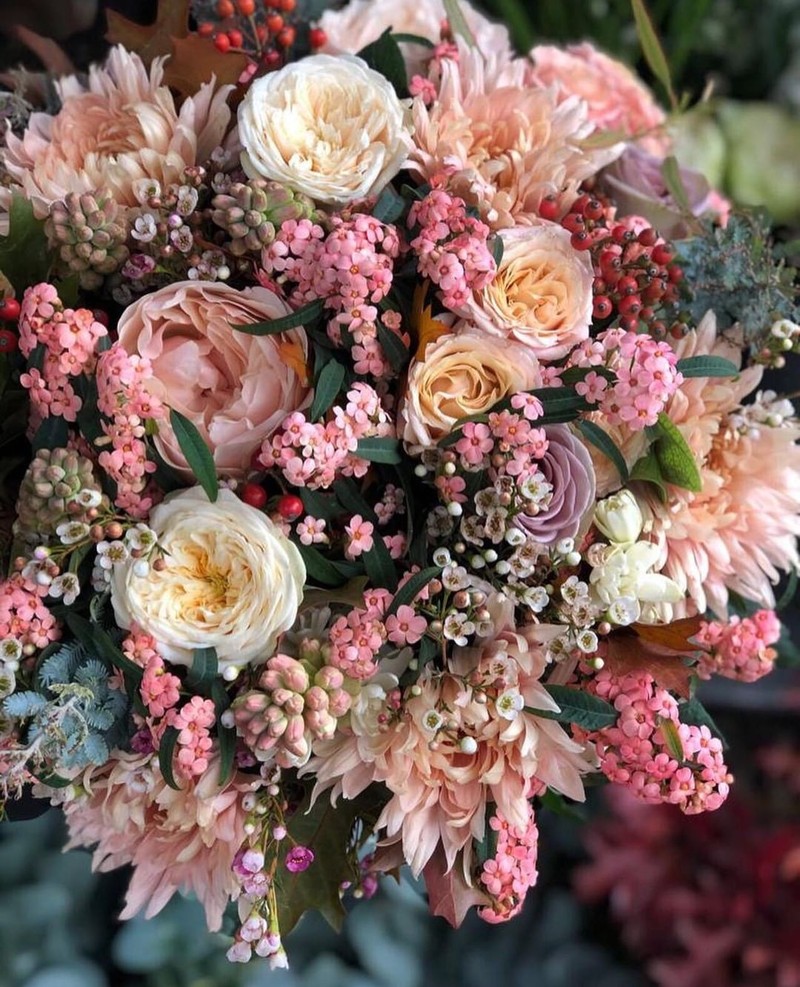
The Best Flowers For Winter Weddings
TRADITIONAL
What To Pick
Nikki Tibbles, founder, Wild at Heart says: “Go for beautiful white anemone, ranunculi, roses and hellebores – they are all classic choices for a winter wedding. For me, all-white blooms represent winter with a traditional feel.”
Philippa Craddock, founder and creative director, Philippa Craddock says: “With more limited options than other seasons, choosing flowers in winter is actually that much easier. If you’ve dreamed of garden roses and/or peonies but have also opted for a winter wedding, then the most traditional blooms include blousy ranunculi (opt for the Hanoi varieties which are wonderfully generous in size) and double tulips (with their multiple layers of petals) – both are perfect alternatives.”
Michal Kowalski, master florist, Blooming Haus says: “Roses are always a safe bet. There are, however, new cultivars that are worth knowing about. They will give your arrangements a nice touch and make them look more cared for. Peach ranunculi are an absolute favourite – they are full of character and their gradating colour will make you fall in love with them, too.”
How To Style Them
Michal: “Go for classically round form, no abstraction – make sure all your arrangements are perfectly symmetrical, but give them some space and don’t pack them too tight. Looser arrangements are more fashionable, even for a traditionalist.”
Nikki: “All white flowers with the addition of hellebores gives a lovely depth to the greenery.”
Philippa: “For a more traditional style, create loose, wild, country designs, paired with beautiful evergreen foliage – scented eucalyptus works beautifully, particularly populous with the added berry detail.”
CONTEMPORARY
What To Pick
Michal: “Choose line flowers (think long stems, unusual shapes and textures) such as leathery anthuriums, exotic birds of paradise or South African proteas. These will give your wedding some stylish edge.”
Nikki: “Bright colours are the way to go – think a mix of bold colour with beautiful roses in stunning pinks, deep reds, apricots and oranges.”
Philippa: “Keep it minimalist, with delicate, slightly more structural shaped flowers including hellebores and anemones – opt for the deep, aubergine tones for a really striking feel.”
How To Style Them
Philippa: “Go for smaller bouquets, asymmetrical in design, with long lengths of deep-toned raw silk ribbon. On the tables, opt for a series of cut crystal bud vases, each with individual flower stems, placed between a mass of candlelight – it looks incredibly romantic and chic at this time of year. With the current pandemic and the need for more intimate celebrations, atmosphere is essential.”
Michal: “Build up arrangements of the same flower type or create strong groupings. If you like experimenting, complement the colours and look for vibrant and saturated florals. If you’re looking for a toned-down style, stick to harmonious colour schemes or go fully monochromatic. Either use a lot of contrasts or none at all.”
Nikki: “Choose all the same flowers – roses are a timeless choice, and then select as many colours as you want. Mixing the colours together will make a bold statement.”
RUSTIC
What To Pick
Nikki: “Think earthy and natural blooms like garden roses, chocolate cosmos (which come with a divine scent), deep burgundy astilbe and beautiful majolica roses, the latter of which look like porcelain.”
Philippa: “For rustic designs, look directly to nature and your surrounding environment. For example, if you’re surrounded by woodlands and forests, then pick woodland flowers, including snowdrops, narcissi, wax flowers and snowberries. Incorporate plenty of evergreen foliage such as skimmia, conifer, viburnum tinus and boxwood, plus touches of woodland moss and salix – all of which are beautifully delicate and earthy in feel.”
Michal: “Textural florals are the best way to create a lovely rustic look. Ask your florist to style your arrangements with smaller florals, such as astrantias, or even early blooming branches, such as genestras. Together with tulips, they’ll remind guests of the approaching spring season and elevate the tablescape.”
How To Style Them
Philippa: “Keep the flowers in plant form with the roots still attached and growing – look for potted snowdrops and narcissi (and replant them in your garden afterwards – a beautiful memory over the following years). Place everything into aged clay pots and finish with details of moss (to cover the soil) and delicate branches of salix. Add elegant bronze candlesticks and tapered dining candles to help the designs feel more considered.”
Nikki: “For rustic bouquets, opt for a slightly wilder look. Add a trailing ribbon and feathery astilbe to add some charm.”
Michal: “Wild and organically styled centrepieces and bouquets fit this look. A light and airy feel is on trend, so you don’t need to use too many flowers. Remember, less is more.”
Finally, Some Tips For A Winter Bridal Bouquet…
Nikki: “There isn’t much difference in choosing your flowers during these times. Always buy your wedding dress first, as this is key, and then choose a bouquet to complement it. Covid or no Covid, you deserve to have what you want.
Michal: “The Blooming Haus ethos is to care about the environment and sustainability, so during this time, our biggest tip for brides that share this passion is to use florals which are seasonal and haven’t been flown halfway across the world.”
Philippa: “Given the difference in weddings right now, embrace the intimacy and more personal feel and think about creating your very own bridal bouquet (or enlist a family member or a friend). In our forthcoming online wedding flowers masterclass, you’ll be taken through every design and detail, and we’ll also answer any questions you might have.”
INSPIRATION CREDITS: Instagram.com/WildAtHeartHQ, Instagram.com/PhilippaCraddock
DISCLAIMER: We endeavour to always credit the correct original source of every image we use. If you think a credit may be incorrect, please contact us at info@sheerluxe.com.







